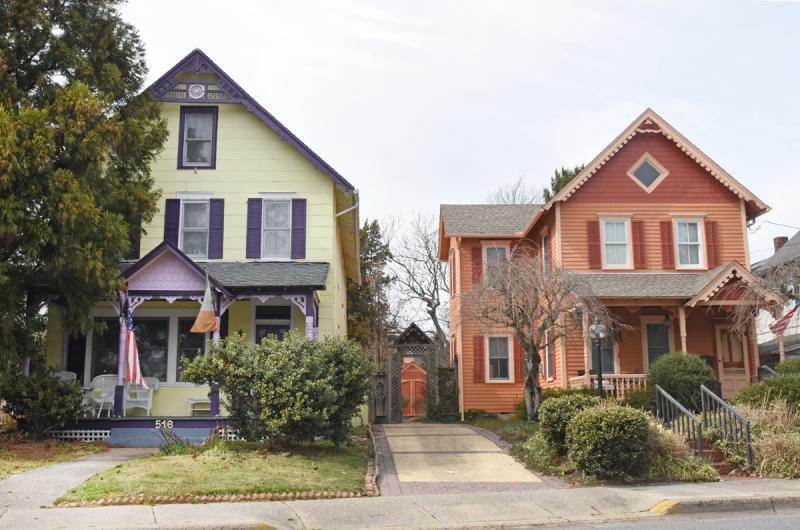Survey underway to update Lewes historic records
The Historic Preservation Commission is in the third year of updating its records on the more than 700 homes in the Lewes Historic District.
When complete, the commission will have a comprehensive, up-to-date list of the city’s historic homes, making it easier for commissioners and homeowners to plan and make decisions about future renovation and rehabilitation projects.
Commission Chair Elaine Simmerman approached mayor and city council March 2, seeking $61,000 over the next two years to expedite the project. The survey so far has been funded through a grant with the Council of Local Governments and matching funds, but, Simmerman said, at its current pace, it would take 10 years to complete the project. By then, she said, the information could be out of date.
City council may not be able to fully accommodate Simmerman’s request. At its March 9 meeting, council budgeted just $15,000 for the upcoming fiscal year for the project. Stuck with a $150,000 budget deficit, council has opted to stretch the $61,000 request over four years, said City Manager Paul Eckrich, although that decision is not final until council passes the budget Monday, March 20.
The survey is being done in conjunction with the University of Delaware’s Center for Historic Architecture and Design. UD students did much of the research in the first two years of the survey, but the program was discontinued. Last year, volunteers in Lewes picked up the ball and continued the work.
At the conclusion of the survey, CHAD will provide a summary of its findings and offer recommendations.
A possible outcome from the survey is the inclusion of more historic homes, either through expanding the historic district or including newer homes. Currently, only homes built prior to 1941 can be considered historic. Simmerman said a 50-year standard is typically used to deem a home historic, meaning the updated survey could result in homes built circa 1970 being added to the historic list.
The final report could offer recommendations regarding the designation of specific homes, including whether some homes should be removed and listed as noncontributing (nonhistoric). This could occur where overzealous renovation adversely affects the home’s historic value, making it no longer significant.
CHAD will upload all homes surveyed to the State Historic Preservation Office’s new online mapping database, the Cultural and Historical Resource Information System, where the public will have access.
A report on each individual home will feature a color photograph along with important information, such as an architectural description, style and the materials used on the home. Materials are very important, Simmerman said.
“We’re always trying to bring the property back to its period of significance,” she said.
There was a time in Lewes when it was popular to put vinyl siding over cedar or cypress siding. By peeking under the vinyl and documenting the original material, it can help the commission with future decisions, she said.
Any additional information that can be provided about a home can go a long way toward making the correct decision on renovations to a historic home, she said.
“Typically, we get a full house design, and we have two weeks [before the meeting] to look at it,” she said. “Then we have a meeting and usually we make a decision in one meeting. It’s a huge responsibility to ask of volunteers. It’s a lot to get right every time.”
Simmerman said she is proud that Lewes takes the lead in Delaware’s historic preservation efforts.
“The amount of respect and admiration for Lewes is palpable,” she said.
The Lewes Historic District was added to the National Register of Historic Places in 1977. Mayor and city council created historic district ordinances and architectural guidelines in 1984, but they were never enacted. In 2000, the city formed the historic district design regulations ad hoc committee, the precursor to today’s historic preservation commission.
Simmerman said the project is important because it reinforces the city’s dedication to preserving its history, one of Lewes’ six core values.
“It’s good for commerce. It’s good for tourism. It’s good for Delawareans,” she said.
Nick Roth is the news editor. He has been with the Cape Gazette since 2012, previously covering town beats in Milton and Lewes. In addition to serving on the editorial board and handling page layout, Nick is responsible for the weekly Delaware History in Photographs feature and enjoys writing stories about the Cape Region’s history. Prior to the Cape Gazette, Nick worked for the Delmarva Media Group, including the Delaware Wave, Delaware Coast Press and Salisbury Daily Times. He also contributed to The News Journal. Originally from Boyertown, Pa., Nick attended Shippensburg University in central Pennsylvania, graduating in 2007 with a bachelor’s degree in journalism. He’s won several MDDC awards during his career for both writing and photography. In his free time, he enjoys golfing, going to the beach with his family and cheering for Philadelphia sports teams.





















































